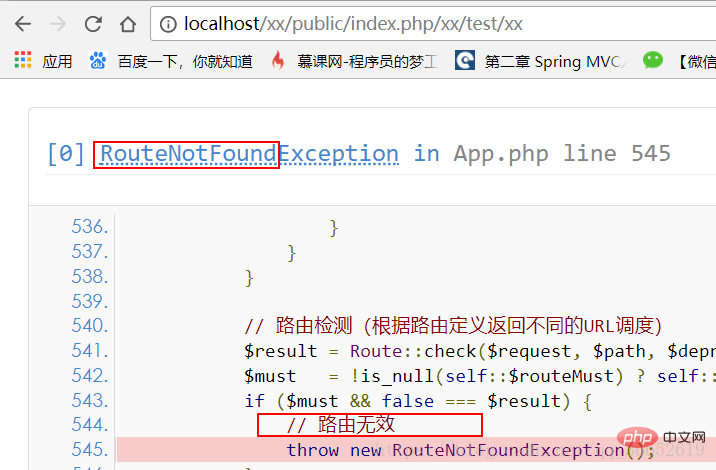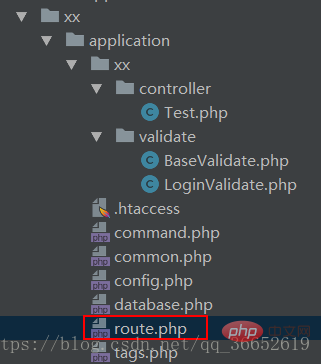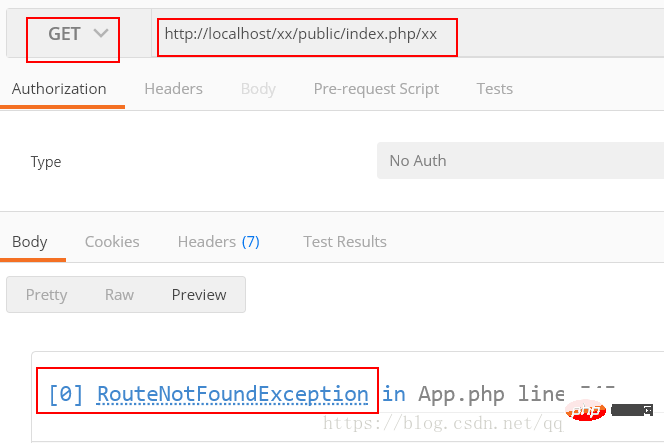what is thinkphp routing
In thinkphp, routing refers to the mapping assigned to the corresponding handler according to the URL; its function is to simplify the URL access address and make correct parsing according to the defined routing type. Simply put, routing is the parsing of a path. According to the path submitted by the client, the request is parsed to the corresponding module or controller or method.

The operating environment of this tutorial: Windows 7 system, thinkphp v5.1 version, Dell G3 computer.
Let’s study the routing mechanism of ThinkPHP5.
Although the complete development manual of TP5 talks about routing very clearly, we still study what the routing of TP5 is all about in this article. After all, reading a blog is more comfortable than reading a book.
First of all, ask three questions:
1. What is Route (routing)?
Route (route) refers to the mapping assigned to the corresponding handler based on the url.
Simply put, it is a path analysis. According to the path submitted by the client, the request is parsed to the corresponding module/controller/method.
The official document is defined like this=>The role of routing is to simplify URL access addresses and make correct parsing based on the defined routing type.
Manual explanation: When we usually access our ThinkPHP project according to our habits, the regular url should be written like this, (local example) http:// localhost/project name/public/index.php/module name/controller name/method name
After entering a string of URLs, you will feel very desperate, (whispering) = > "I just want to test a small interface that allows me to type such a long list of addresses. The address is too long and I can't remember it...". At this time, we can use routing to simplify his address, and define some rules while shortening the address.
2. Why use routing?
Some people may blurt out: To simplify the path. Of course, this is one of the reasons, but the reason is not that simple.
Simplifying the path is a big reason, because I thought the path was too long at first and ran over to turn it on. But later in the process of using it, I discovered the role of Route. In fact, it is not limited to simplified paths.
We can enable the forced use of routes so that everyone can only come in through the routes I defined. This has the advantage that you write some controllers that you don’t want users to access. Scripts, if you enable full routing for forced use, users will not be able to access these scripts. Otherwise, if users access these scripts and the scripts sometimes modify the database, it will be more dangerous.
Also, we can define whether it is a get operation or a post operation coming in from this path, so that there will be no situation like before. With a controller method, you can also get it from the get operation. It can be accessed, and post can also be accessed, which is very confusing. Of course, some people will say that it is not a big deal if both get and post can be accessed. In fact, it is more helpful to distinguish between these methods to embody the idea of Restful API. of.
Similarly, I won’t talk about the regulations of http and https.
At this point, do you think routing is a bit magical? It turns out that it can do so many things, so let’s study how to use it.
Using Route
Before using it, let’s first understand the configuration information. It’s still my fork project , open the config file:

There are two things to pay attention to, first of all, inside the first red box By default, tp turns on the routing mode for us. In the second red box, tp turns off the forced use of routing by default. What does it mean? Even now I can access successfully through our usual address mode, and access through routing can also be successful.

When I usually do projects, I will change this to true for safety reasons, so let’s take a look at the effect
Future When turning on forced routing:

Accessing according to the regular address can be successful, so let’s turn on forced routing now:

The same address reported an error and threw a route not found error. Because we did not define this route in the routing file, it threw an error. It shows that we are now forced to use routing.
So let’s define it now. First, start with the simplest one:

Find the route file

First of all, we need to introduce the routing class under think, and then we call the get static method inside. From the method name, we can easily know that this is accessed through the get method. , so what do the first and second parameters represent? The second parameter represents the module/controller/method in the regular URL, and the first parameter represents the name you want to use to replace the following module/controller/ method.
In other words, I originally used http://localhost/xx/public/index.php/xx/test/xx to access my controller method, but now I only need http://localhost/ xx/public/index.php/xx can access my controller method.
Look at the effect:

Successfully used routing access, then, let’s take a closer look at the formulation of this rule (for example, get and The difference between post access)
I now change the get method to the post method and then I use the get method to access and see what happens:



You can see that we use get which is not accessible. Only post can be accessed. How do you feel? Is routing a fun place?
More deeply, we can also define the route like this:

The third parameter represents the access method, like what I defined here This form is accessible to both get and post operations. The last parameter represents whether to check the https protocol. If it is false, https will not be checked. If it is true, we will not be able to find it when we use http to access it. In this way, we can further ensure the security of our interface. As for the effect, I won’t demonstrate it.
More
What else is special about routing? Routing can even merge the parameters passed by the get operation into the url. Our original get operation should look like this: url? id=1. After routing, we can define it as url/1. In this way, even the id parameter is hidden. Everyone knows the benefits. As for the process, just go to the development manual and search for it.
Of course, routing also has some other auxiliary functions, such as closure functions and so on. I will not introduce them one by one, because this auxiliary function is not very important during the development process. It is commonly used. If you are interested, you can go to the complete development manual to read it.
The relevant introduction to routing and the benefits of using routing are introduced here.
[Related tutorial recommendations: thinkphp framework]
The above is the detailed content of what is thinkphp routing. For more information, please follow other related articles on the PHP Chinese website!

Hot AI Tools

Undresser.AI Undress
AI-powered app for creating realistic nude photos

AI Clothes Remover
Online AI tool for removing clothes from photos.

Undress AI Tool
Undress images for free

Clothoff.io
AI clothes remover

AI Hentai Generator
Generate AI Hentai for free.

Hot Article

Hot Tools

Notepad++7.3.1
Easy-to-use and free code editor

SublimeText3 Chinese version
Chinese version, very easy to use

Zend Studio 13.0.1
Powerful PHP integrated development environment

Dreamweaver CS6
Visual web development tools

SublimeText3 Mac version
God-level code editing software (SublimeText3)

Hot Topics
 How to run thinkphp project
Apr 09, 2024 pm 05:33 PM
How to run thinkphp project
Apr 09, 2024 pm 05:33 PM
To run the ThinkPHP project, you need to: install Composer; use Composer to create the project; enter the project directory and execute php bin/console serve; visit http://localhost:8000 to view the welcome page.
 There are several versions of thinkphp
Apr 09, 2024 pm 06:09 PM
There are several versions of thinkphp
Apr 09, 2024 pm 06:09 PM
ThinkPHP has multiple versions designed for different PHP versions. Major versions include 3.2, 5.0, 5.1, and 6.0, while minor versions are used to fix bugs and provide new features. The latest stable version is ThinkPHP 6.0.16. When choosing a version, consider the PHP version, feature requirements, and community support. It is recommended to use the latest stable version for best performance and support.
 How to run thinkphp
Apr 09, 2024 pm 05:39 PM
How to run thinkphp
Apr 09, 2024 pm 05:39 PM
Steps to run ThinkPHP Framework locally: Download and unzip ThinkPHP Framework to a local directory. Create a virtual host (optional) pointing to the ThinkPHP root directory. Configure database connection parameters. Start the web server. Initialize the ThinkPHP application. Access the ThinkPHP application URL and run it.
 Which one is better, laravel or thinkphp?
Apr 09, 2024 pm 03:18 PM
Which one is better, laravel or thinkphp?
Apr 09, 2024 pm 03:18 PM
Performance comparison of Laravel and ThinkPHP frameworks: ThinkPHP generally performs better than Laravel, focusing on optimization and caching. Laravel performs well, but for complex applications, ThinkPHP may be a better fit.
 How to install thinkphp
Apr 09, 2024 pm 05:42 PM
How to install thinkphp
Apr 09, 2024 pm 05:42 PM
ThinkPHP installation steps: Prepare PHP, Composer, and MySQL environments. Create projects using Composer. Install the ThinkPHP framework and dependencies. Configure database connection. Generate application code. Launch the application and visit http://localhost:8000.
 Java Apache Camel: Building a flexible and efficient service-oriented architecture
Feb 19, 2024 pm 04:12 PM
Java Apache Camel: Building a flexible and efficient service-oriented architecture
Feb 19, 2024 pm 04:12 PM
Apache Camel is an Enterprise Service Bus (ESB)-based integration framework that can easily integrate disparate applications, services, and data sources to automate complex business processes. ApacheCamel uses route-based configuration to easily define and manage integration processes. Key features of ApacheCamel include: Flexibility: ApacheCamel can be easily integrated with a variety of applications, services, and data sources. It supports multiple protocols, including HTTP, JMS, SOAP, FTP, etc. Efficiency: ApacheCamel is very efficient, it can handle a large number of messages. It uses an asynchronous messaging mechanism, which improves performance. Expandable
 How is the performance of thinkphp?
Apr 09, 2024 pm 05:24 PM
How is the performance of thinkphp?
Apr 09, 2024 pm 05:24 PM
ThinkPHP is a high-performance PHP framework with advantages such as caching mechanism, code optimization, parallel processing and database optimization. Official performance tests show that it can handle more than 10,000 requests per second and is widely used in large-scale websites and enterprise systems such as JD.com and Ctrip in actual applications.
 Development suggestions: How to use the ThinkPHP framework for API development
Nov 22, 2023 pm 05:18 PM
Development suggestions: How to use the ThinkPHP framework for API development
Nov 22, 2023 pm 05:18 PM
Development suggestions: How to use the ThinkPHP framework for API development. With the continuous development of the Internet, the importance of API (Application Programming Interface) has become increasingly prominent. API is a bridge for communication between different applications. It can realize data sharing, function calling and other operations, and provides developers with a relatively simple and fast development method. As an excellent PHP development framework, the ThinkPHP framework is efficient, scalable and easy to use.






